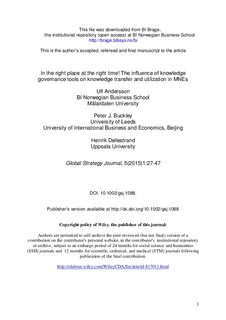| dc.contributor.author | Andersson, Ulf | |
| dc.contributor.author | Buckley, Peter J. | |
| dc.contributor.author | Dellestrand, Henrik | |
| dc.date.accessioned | 2015-08-12T12:50:37Z | |
| dc.date.available | 2015-08-12T12:50:37Z | |
| dc.date.issued | 2015 | |
| dc.identifier.citation | Global Strategy Journal, 5(2015)1:27-47 | nb_NO |
| dc.identifier.issn | 2042-5791 | |
| dc.identifier.issn | 2042-5805 | |
| dc.identifier.uri | http://hdl.handle.net/11250/296396 | |
| dc.description | This is the author’s accepted and refereed manuscript to the article | nb_NO |
| dc.description.abstract | This article examines the utilization of knowledge transferred between sending and receiving subsidiaries within multinational enterprises. A model was developed and tested on 169 specific knowledge transfer projects. The model explains the utilization of knowledge subject to transfer in terms of hierarchical governance tool efficacy and lateral relationships within the multinational enterprise. The results show that headquarters’ involvement during knowledge development does not have any significant impact on subsequent knowledge utilization in the receiving units and, in fact, hierarchical governance forms have a negative impact on knowledge utilization. However, lateral relationships are positive stimuli to building subsidiary capabilities in the knowledge transfer process that enhance receiving unit knowledge utilization. | nb_NO |
| dc.language.iso | eng | nb_NO |
| dc.publisher | Wiley | nb_NO |
| dc.title | In the right place at the right time! The influence of knowledge governance tools on knowledge transfer and utilization in MNEs | nb_NO |
| dc.type | Journal article | nb_NO |
| dc.type | Peer reviewed | nb_NO |
| dc.source.journal | Global Strategy Journal | nb_NO |
| dc.identifier.doi | 10.1002/gsj.1088 | |
| dc.description.localcode | 1, Forfatterversjon | nb_NO |
